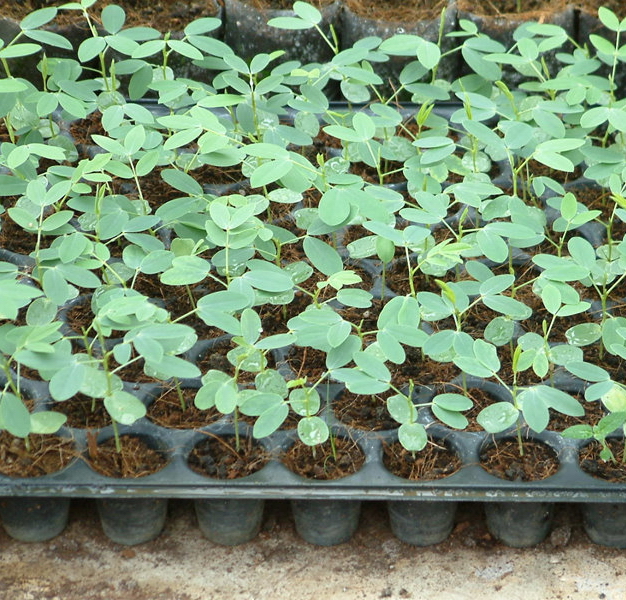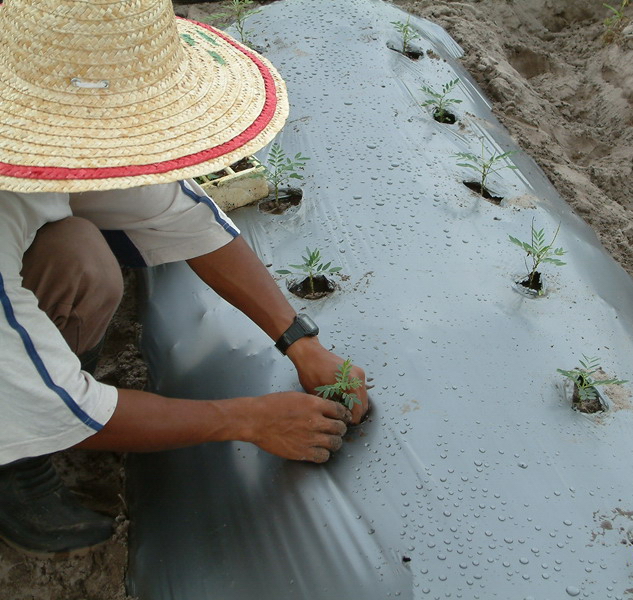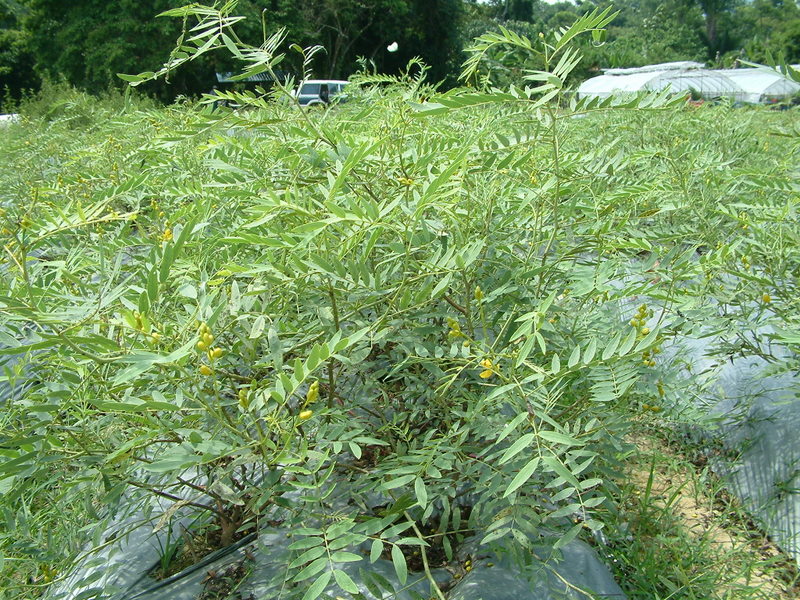Scientific Name
Senna alexandrina Mill
Synonyms
Cassia acutifolia Delile, Cassia alexandrina (Garsault) Thell., Cassia angustifolia M.Vahl, Cassia angustifolia Vahl , Cassia senna L., Senna acutifolia (Delile) Batka, Senna alexandrina Garsault, Senna angustifolia (Vahl) Batka. [1]
Vernacular Name
| Malaysia | Senna mekah [2] |
| English | Indian Senna, senna, cassia senna, tinnervelly senna, mecca senna, tinnevally senna [2] |
| China | Fan xia ye [2] |
| India | Nilavarai, nelavakai [2] |
| Thailand | Makham khaek [2]. |
Geographical Distributions
Senna alexandrina is native to Yemen. The plant is commercially grown in Southern India especially in Tamil Nadu dan Gujarat. This plant has potential to be grown under our local condition. With good agricultural practices, this plant is able to produce 7-8 t/ha of fresh leaf yield. [3]
Botanical Description
S. alexandrina is a member of Leguminosae family. The plant is an annual crop and can grow up to 60-100 cm tall. The stem is woody, branching profusely and of light green. The leaf is pinnate with several leaflets. The flower bud appears at about 40 days after transplanting and reaches full bloom at about 65 days. The flower is bright yellow. The seed pod becomes visible at about 75 days after transplanting. It produces small yellow flowers with oblong seed pods containing several dark brown seeds. It directs a pale green stem with leaf branches having up to five leaves. The pod is thin, slender and soft with an average length of 3.5-6.5 cm and width of 1.5-2.0 cm. As the pod matures, the pod colour changes from green to greenish-brown, to dark brown and black. Under local condition, each seed pod contains 5-8 seeds. [3]
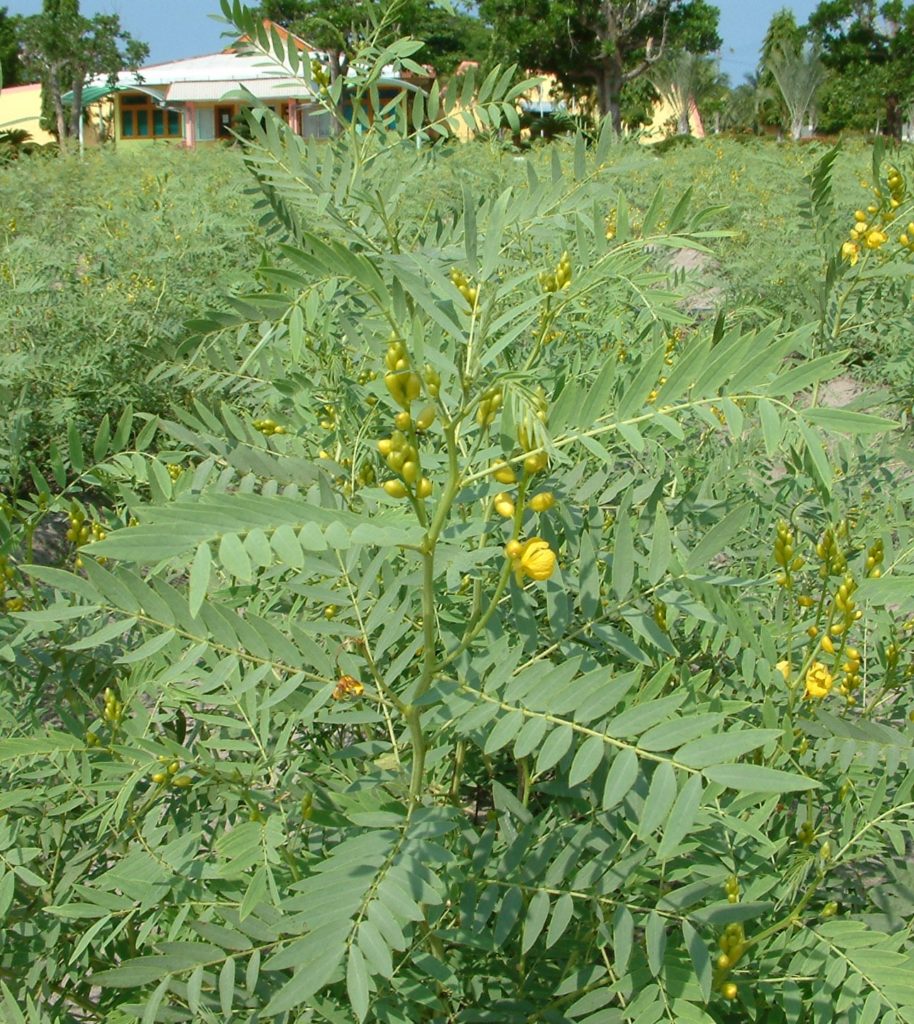
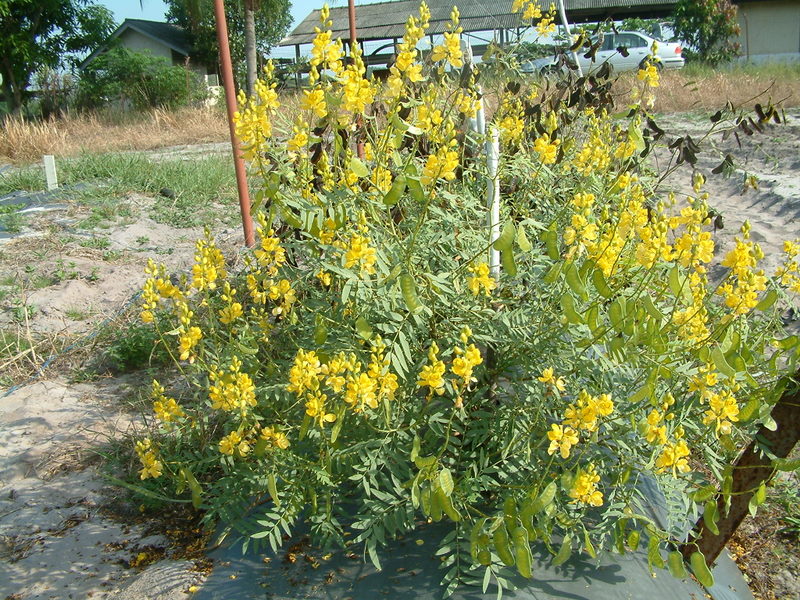
Cultivation
Soil Suitability and Climate Requirement
S. alexandrina is suitable for planting on sandy loam and clay loam soils. Sandy soils such as bris can also be planted with S. alexandrina. This plant is sensitive to stagnant water, heavy rain and low temperature conditions. The plant performs well under full sunlight thus suitable for drier areas or short rainfall season. Average monthly rainfall about 25-40 cm is adequate for satisfactory growth of S. alexandrina. [3]
Field Preparation
Land Preparation
Good land preparation is very important for good control of weeds and crop establishment. The planting area has to be ploughed once with a disc plough followed twice using a rotovator. [3]
Production of Planting Materials
The planting of S. alexandrina can be done by seeding directly into the planting hole in the field. About 6 kg of seeds is sufficient for one hectare of planting area. The seed treatment such as hot water treatment is recommended, to improve germination percentage, as the seed coat is thick and hard. Normally, the S. alexandrina seeds start to germinate 4-5 days after sowing and can be transferred into polybags or plastic trays when reaching the 2-3 leaf stage. [3][4]
Figure 3: S. alexandrina seedlings were raised in plastic tray. [3]
Field Planting
The soil should be ploughed twice before planting to provide a suitable growing condition. The planting distance recommended is 45-50 cm between rows and 30 cm between plants, which gives a population density of 66, 700-74, 100 plants/ha. Planting during rainy season is not recommended to avoid heavy infestation of fungal diseases on stem and roots. [3][5]
Figure 4: Planting of S. alexandrina on sandy soil. [3]
Figure 5: Field production ofS. alexandrina. [3]
Field maintenance
Fertilisation
The recommended fertiliser rate is 80, 30 and 20 kg/ha of N, P2O5 and K2O respectively. Compound fertiliser 15:15:15 at the rate of 30 kg/ha is 10-15 days after transplanting. Urea (46% N) at 25 kg/ha is applied immediately after each harvest at about 55 and 95 days after transplanting. Urea is broadcasted 4-5 cm under the plant canopy. Fertigation can also be done at the same rate as applied in the manual method. The fertigation frequency is 20-30 times throughout the crop growth. [3]
Weed Control
Manual control of weeds in the planting area especially at 25-30 and 75-80 days after transplanting helps in promoting better growth and yield of this plant. Plastic mulching can also provide good control of weeds provided suitable irrigation system is used, such as drip. [3]
Water management
The plant requires adequate amount of water for normal growth especially at the beginning of the planting season. Irrigation is also required after every harvest to promote the growth of new shoots, especially in hot season. The amount of irrigation water should be reduced after the fruit has been formed to minimise the fruit from being infested with fungus disease. If drip system is used for irrigation, the frequency should be maintained at 3 times a week throughout the growth period. [3]
Pest and Disease Control
Damping-off is the major disease during the seedling stage. This disease spreads easily under wet/damp condition. The problem can be solved if by practising good sanitary practices. Major pest for this plant is leaf eating caterpillar Pieris sp., which normally feeds on the young leaf. This pest can be controlled using Bacillus thuringiensis. [3]
Harvesting
The leaves are harvested 3 times within the 140-150 days period for each planting. The harvesting is done manually using secateurs. The first harvest is 55-65 days (alluvial soil) and 70-85 days (bris sandy soil) after transplanting. The harvest is repeated with an interval of 30-40 days after the prior harvest. About 7-8 t/ha of fresh leaf yield is obtained from the three harvests. This will turn to 1.4 t/ha of dry leaf yield. [3]
Postharvest handling
To obtain a good quality of dried raw material, the harvested leaves should be uniformly distributed in an open area for about 6-10 hours to reduce the moisture. The leaves are then dried for 3-5 days under a well ventilated shade structure until it reaches a moisture content of 10%. The leaves can be dried faster using mechanical method at temperature not exceeding 40°C. The use of low drying temperature is to ensure the bioactive content remains. The dried leaf should be stored in a dry cold room. This method of storage can retain the quality of the raw material for 1-3 years. [3]
Estimated cost of production
Based upon 3 harvests, average production cost per hectare for S. alexandrina is RM5, 770 per season. At a yield level of 1.4 t/ha, the estimated cost of S. alexandrina leaf is about RM4.12/kg. The production cost was estimated based on the cost of current inputs during writing of this article. [3]
Chemical Constituent
S. alexandrina has been reported to containapproximately 3% dianthrone glycosides (sennosides A, A1, B, C, D, E, F & G ); small amounts of anthraquinones including aloe-emodin and rhein 8-glucoside; approximately 10% mucilage; tannins; and flavonoids. [6][7]
Plant Part Used
Leaf and pod. [6]
Traditional Use
The parts used in traditional medicine are the leaf and seed pod. The leaf and seed pod contains anthraquinone glucoside (sennocide), carthartic acid, myricyl alcohol, calcium salt, isohamnentin, rhein anthrone, aloe-emodin glycoside, kampferol dan isormamnetin. The leaf itself contains 2.9-3.9% sennoside and the seed pod contains 3.5-4.0% sennoside. The leaf and seed pod are normally used for treating skin disorders, constipation, anaemia, typhoid, cholera, bronchitis, cough, gout, rheumatism and jaundice.[2][3][5][6]
Preclinical Data
Pharmacology
S. alexandrina has been reported to act as stimulant laxative and categorized as an anthraquinone laxative. S. alexandrina is widely accepted as a stool softener and a short-term treatment for constipation. S. alexandrina has been reported been approved by the World Health Organization (WHO) for short-term use in occasional constipation. S. alexandrina contains hydroxyanthracene glycosides, also called sennosides. Sennosides stimulate peristalsis of the colon along with altering colonic absorption and secretion of fluids, resulting in accumulation of liquids to soften the stool and increased defecation. S. alexandrina has been reported effective in managing constipation associated with a number of causes including surgery, childbirth, and use of narcotic pain relievers. [6][7]
It has been thought that using anthraquinone laxatives, S. alexandrina has been reported to may damage the intestinal epithelial layer of the GI tract and therefore increase the risk of developing colorectal cancer. Sennosides have been found to induce acute massive cell loss in the GIT, probably by apoptosis, causing shorter crypts, and increased cell proliferation. [8] S. alexandrina has been reported contain rhein that showed no cytotoxic and genotoxic effects in colon adenocarcinoma cells. Of interest is that by being antioxidant, rhein actually inhibited cell proliferation via a mechanism that seems to involve the MAP kinase pathway. [9]
Clinical Data
No documentation
Poisonous Management
No documentation
Line Drawing
No documentation.
References
- The Plant List. Ver1.1. Senna alexandrina Mill. [homepage on the Internet]. c2013 [updated 2012 July 14; cited 2016 Nov 15]. Available from: http://www.theplantlist.org/tpl1.1/record/ild-1115
- Herbal Medicine Research Centre, Institute for Medical Research. Compendium of medicinal plants used in Malaysia. Volume 1. Kuala Lumpur: HMRC IMR, 2002; p.151
- Omar T, Ahmad PN, Wan Z, Yahaya H. Senna mekah. In: Penanaman tumbuhan ubatan dan beraroma. (Musa Y, Muhammad G, Mansor P, editors). Selangor: MARDI, 2005; p. 83-89
- Wan ZWM. Development of seedling production technique for senna makki (Cassia angustifolia). Pemantauan projek herba pusat penyelidikan padi dan tanaman industry. Selangor: MARDI, 2004.
- Wan ZWM. Determination of optimum planting distance for senna makki (Cassia angustifolia). Pemantauan projek herba pusat penyelidikan padi dan tanaman industry. Selangor: MARDI, 2004.
- Singh M, Chandhuri PK, Sharma RP. Constituents of the leaves of Cassia angustifolia. Fitoterapia. 1995;66(3):284.
- Kinjo J, Ikeda T, Watanabe K, Nohara J. An anhraquinone glucoside from Cassia angustifolia. Phytochemistry. 1994;37(6):1685-1687.
- Van Gorkom BA, Karrenbeld A, van Der Sluis T, et al. Influence of a highly purified senna extract on colonic epithelium. Digestion. 2000;61(2):113-120.
- Aviello G, Rowland I, Gill CI, et al. Antiproliferative effect of rhein, an anthraquinone isolated from Cassia species, on Caco-2 human adenocarcinoma cells. J Cell Mol Med. 2009:14(7): 2006–2014.
- Barceloux DG. Medical toxicology of natural substances. New Jersey: John Wiley & Sons Pub; 2008. 591-594.
- Kinnunen O, Winblad I, Koistinen P, Salokannel J. Safety and efficacy of a bulk laxative containing senna versus lactulose in the treatment of chronic constipation in geriatric patients. Pharmacol.1993;47(1):253-255.
- Soyuncu S, Cete Y, Nokay AE. Portal vein thrombosis related to Cassia angustifolia. Clin Toxicol (Phila). 2008;46(8):774-777.
- Acs N, Bánhidy F, Puhó EH, Czeizel AE. Senna treatment in pregnant women and congenital abnormalities in their offspring-a population-based case-control study. Reprod Toxicol. 2009;28(1):100-104.
- Vander perren B, Rizzo M, Angenot L, et al. Acute liver failure with renal impairment related to the abuse of senna anthraquinone glycosides. Ann Pharmacother. 2005;39(7-8):1353-1357.
- Agra Y, Sacristan A, Gonzalez M, et al. Efficacy of senna versus lactulose in terminal cancer patients treated with opioids. J Pain Symptom Manage. 1998;15(1):1-7.


